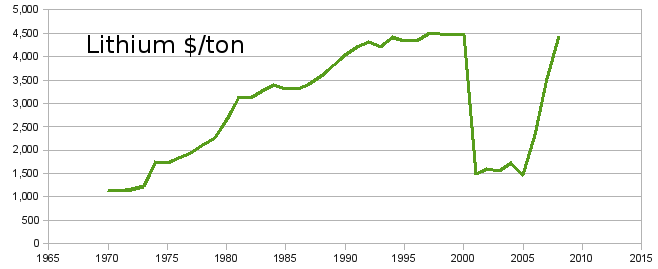| Tikalon Blog is now in archive mode.
An easily printed and saved version of this article, and a link
to a directory of all articles, can be found below: |
|
This article |
| Directory of all articles |
Lithium Supply
June 29, 2010
Historically,
lithium's usefulness lay in just a few industrial applications. It's a component of high temperature glasses and ceramics, since
lithium oxide has a relatively high melting point (1570
oC). Lithium metal is used in a few specialty applications, such as light, high-strength alloys for aerospace applications. Recently, lithium has found an important use in
lithium batteries. Lithium batteries have a much higher energy-storage capacity than common
alkaline batteries, a fact that my digital camera has proved to my satisfaction. Lithium use in the US for consumer electronics applications, mostly batteries, increased from 87 (
metric) tons in 1996 to 290 tons in 2005. Lithium in cellphone batteries increased from 1.8 tons to 170 tons, and the use of litium in computer batteries increased from 3.3 tons to 99 tons in that same period [1]. US lithium consumption in 2008, the last year for which data are available, was 2,300 tons [2].
Lithium is mined in the form of
lithium carbonate in the US, and the most significant foreign source of lithium carbonate is
Chile, with other sources located in
Argentina,
Tibet,
China,
Australia,
Brazil,
Canada,
Portugal and
Zimbabwe [2]. However, the growing demand for lithium has resulted in a significant price increase for the metal (see figure). The price of lithium carbonate increased 26% from 2007 to 2008, and battery makers are scrambling to ensure adequate supplies. Since lithium is now a candidate material for use in electric vehicle batteries, the supply situation will become worse.

Price of Lithium 1970-2008. Data from Ref. 2.
Bolivia is now poised to become a major supplier of lithium [3]. The Bolivian
Andes is thought to contain about half of the Earth's available lithium, and the Bolivian government has launched a program to mine this lithium. The USGS estimates that the Bolivian lithium reserves are about 5.4 million tons, compared with US reserves of just 410,000 tons [3]. Says Jason Forcier of
A123 Systems, an electric vehicle battery manufacturer, "It's fair to compare the lithium reserves in South America to the oil in the Middle East." [3]
Another source of lithium might be
Afghanistan. Afghanistan has been found to contain large deposits of
iron,
copper,
cobalt,
gold and lithium, and Afghanistan is characterized in an internal
Pentagon memo as a potential "
Saudi Arabia of lithium." [4] China has invested in a copper mine in Afghanistan, and it's believed that this investment was secured through $30 million in bribes [5], an apparently customary business practice in Afghanistan.
References:
- D.R. Wilburn, "Material use in the United States-Selected case studies for cadmium, cobalt, lithium, and nickel in rechargeable batteries," U.S. Geological Survey Scientific Investigations Report 2008-5141 (2008).
- Lithium - Statistics and Information USGS 2008.
- David Abel, "Tech-age buried treasure - Big lithium reserve could make Bolivia a key energy player, supplier to US battery makers," Boston Globe Online (February 15, 2010).
- Afghanistan 'holds $1 trillion in mineral deposits' Times UK Online (June 14, 2010).
- Afghan riches: Mineral wealth raises questions for the U.S., Pittsburgh Post-Gazette (June 16, 2010).
Permanent Link to this article